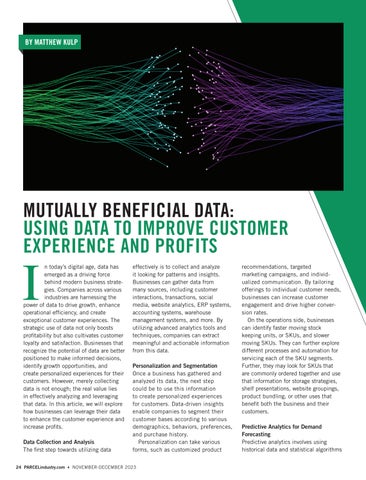BY MATTHEW KULP
MUTUALLY BENEFICIAL DATA: USING DATA TO IMPROVE CUSTOMER EXPERIENCE AND PROFITS
I
n today’s digital age, data has emerged as a driving force behind modern business strategies. Companies across various industries are harnessing the power of data to drive growth, enhance operational efficiency, and create exceptional customer experiences. The strategic use of data not only boosts profitability but also cultivates customer loyalty and satisfaction. Businesses that recognize the potential of data are better positioned to make informed decisions, identify growth opportunities, and create personalized experiences for their customers. However, merely collecting data is not enough; the real value lies in effectively analyzing and leveraging that data. In this article, we will explore how businesses can leverage their data to enhance the customer experience and increase profits. Data Collection and Analysis The first step towards utilizing data
effectively is to collect and analyze it looking for patterns and insights. Businesses can gather data from many sources, including customer interactions, transactions, social media, website analytics, ERP systems, accounting systems, warehouse management systems, and more. By utilizing advanced analytics tools and techniques, companies can extract meaningful and actionable information from this data. Personalization and Segmentation Once a business has gathered and analyzed its data, the next step could be to use this information to create personalized experiences for customers. Data-driven insights enable companies to segment their customer bases according to various demographics, behaviors, preferences, and purchase history. Personalization can take various forms, such as customized product
24 PARCELindustry.com NOVEMBER-DECEMBER 2023
recommendations, targeted marketing campaigns, and individualized communication. By tailoring offerings to individual customer needs, businesses can increase customer engagement and drive higher conversion rates. On the operations side, businesses can identify faster moving stock keeping units, or SKUs, and slower moving SKUs. They can further explore different processes and automation for servicing each of the SKU segments. Further, they may look for SKUs that are commonly ordered together and use that information for storage strategies, shelf presentations, website groupings, product bundling, or other uses that benefit both the business and their customers. Predictive Analytics for Demand Forecasting Predictive analytics involves using historical data and statistical algorithms
